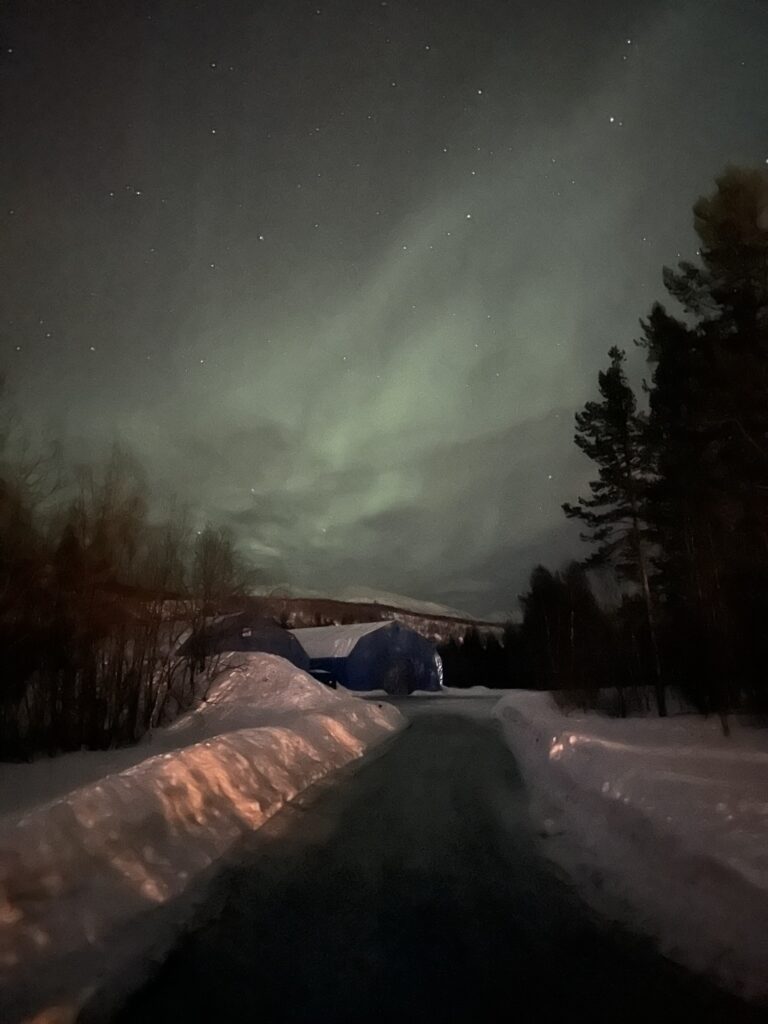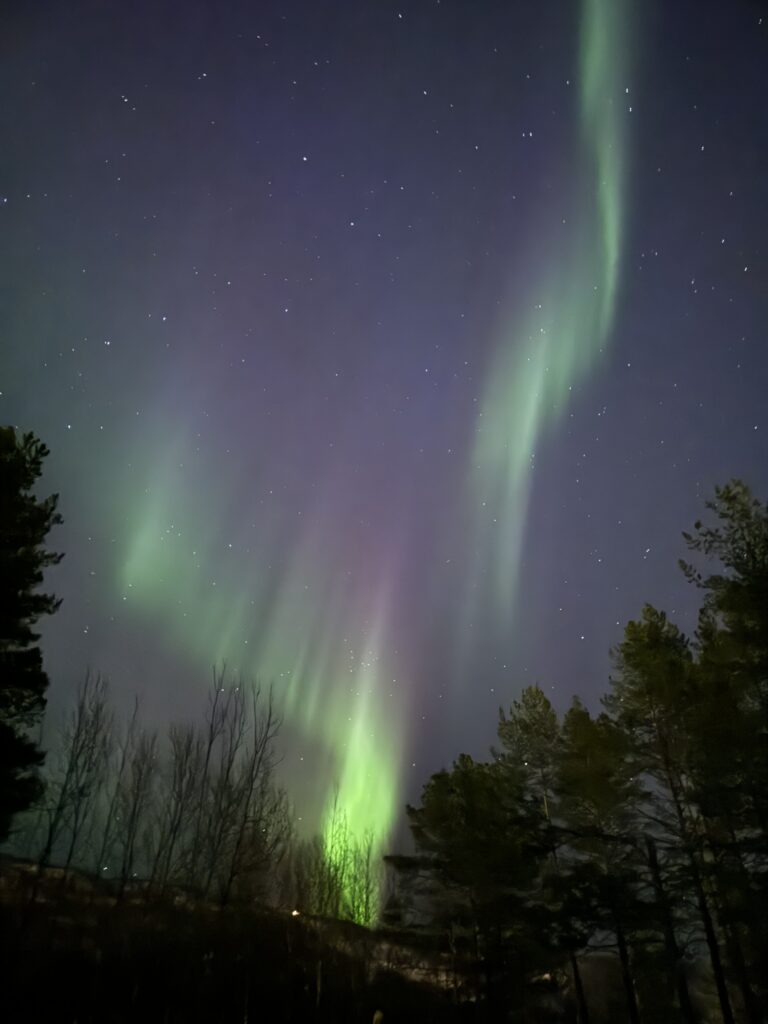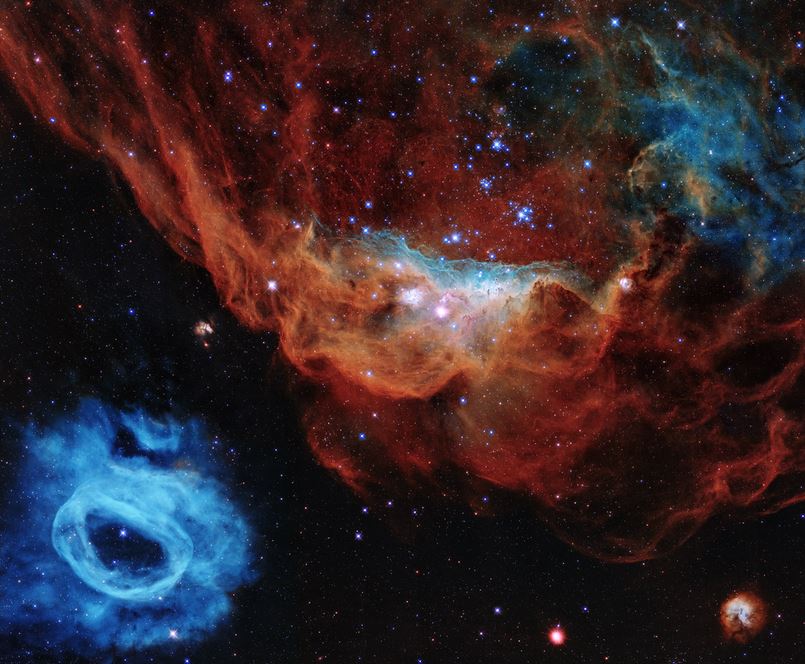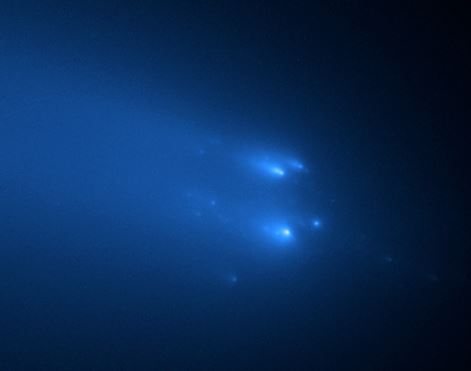Notes from Our March 22, 2024 Meeting
This was our 86th meeting and the last meeting was a long 21 weeks ago. Our meetings are becoming a little sparce with only 3 of them in 2023. But it was great to get the band back together. Dean, Laura, Phil, Don, Dave, Beth, Chad and myself were in attendance.
The theme for tonight was the new Artemis timeline for returning US and other countries astronauts to the surface of the moon.

I proudly showed my Lego build of the Perseverance Mars rover and the Ingenuity helicopter. It was a birthday present for my 3/4 of a century. Time flies when you’re having fun. Dean showed me an eyepiece he purchased for his telescope that clips on to a regular eyepiece and then broadcasts a wifi signal that allows you to see the image on a phone or computer. You can record still shots and movie clips. It will be cool to see it in operation, maybe at a future meeting.
I also recommended to the group the new Netflix series “3 Body Problem”. It is based on the sci-fi trilogy with the same name written by a Chinese author. I thoroughly enjoyed the books but it was a hard read with the Chinese names of the characters. The English translation of Chinese has way too many “x”s in it. Dave recommended a sci-fi series called “Dust” streaming on the Pluto channel. I’ll have to check that out.
Intro Items
I shared some photos from my grandson, Andrew, who is currently a US Marine and participating in a NATO exercise with about 20,000 other troops near the Artic Circle in Norway. He gets to see the Northern Lights on a nightly basis. I’m envious about his view but wouldn’t want to share the other hardships he is experiencing.




After sharing the photos, I showed the following YouTube video. It came as a link from my brother-in-law who is a big trucker “gear-head”. You never know where your next space related Internet content is coming from. I was amazed how up-to-date the trucker was about the timing of the Crew-7 Dragon capsule re-entry. I wish I had known and I might have tried to see if we could see it from Illinois. I think I’ll monitor future Dragon entry profiles in the future, but NASA is usually quiet about the specifics so that the boaters down in Florida don’t swarm the capsule while it is waiting for pickup in the ocean. This capsule came down off Pensacola, Florida. Here is the video.
My next short video was the NASA X-59 Low Boom experimental aircraft. First flight is a little uncertain but it probably will be over-flying the cities of the US in 2024. It is amazing the length of the nose at over 30 ft long and the fact that the pilot can’t see straight ahead and has to rely on a video screen to see what he is flying into. It is hoped that the aerodynamic profile of the plane will reduce sonic booms to the sound of someone closing a car door across the street. I still remember the X-58 Hustler’s flying over my house in Milwaukee in the 1960’s and making loud sonic booms. That was why the Concorde was restricted from over-flying the US at supersonic speeds. NASA is hoping to get feedback from people experiencing the thuds from the X-59. We’ll see how it goes.
On a sadder note, another Apollo astronaut has died, Tom Stafford passed away at the age of 93 on March 18. He commanded the Apollo 10 dress rehearsal of the moon landing and also commanded the Apollo-Soyuz mission with Russia in July 1975. Earlier in his career, he went to space on the Gemini 6 and 9 missions. Stafford was one of only 24 astronauts who flew to the moon. Only 7 of them are still alive. We still have Lovell from Apollo 8 and 13, Anders from Apollo 8, Haise from Apollo 13, Aldrin from Apollo 11, Scott from Apollo 15, Duke from Apollo 16 and Schmitt from Apollo 17. All of these guys are 89 years or older. Only 4 of the 12 that walked on the moon are still alive, Aldrin (Apollo 11), Scott (Apollo 15), Duke ( Apollo 16) and Schmitt (Apollo 17). Hopefully when can get back to the moon before this generation is gone. Only 4+ years if you believe the current Artemis schedule.
Solar Eclipse Coming
Only 17 days from our meeting date, a total solar eclipse is coming to the US on April 8, 2024, the likeliness of cloud cover increases as the eclipse proceeds from Texas, across southern Illinois and Indiana, and then out over the northeastern states. Texas has the best historical chance of clear skies, Arkansas is a little less, and the rest of the US is lower than that. Here is a map from Sky & Telescope Magazine with the chances listed.
I was surprised that a couple of MASS members were not going to the eclipse. Dean said he is not going and Beth and Chad were not going to Texas like I thought they might. I think Keith is still planning an Indianapolis area visit. Carol and I might be like Richard Dreyfuss in the movie “Close Encounters of the Third Kind”. We will monitor cloud conditions a few days before the eclipse and see where conditions are right. I hope we aren’t scaling a scrub laden hill to grab a glimpse of the event. I like creature comforts like bathroom facilities and other amenities. I hear some of the hotels are gouging people for almost $1000 a night and making people pay for multiple nights.
The 13 year solar cycle is heading for a maximum in late 2024. Here is how the latest sunspot number index has been trending. With the sun at solar maximum it should make for a very prominent solar corona. The latest number from February 2024 is a sunspot number of 124.7 actual compared to the predicted number of 97.3. It looks like this maximum will be higher than predicted.
Space Missions
We listened to an episode of Space Bites from Fraser Cain to kick off this topic. He spoke about layoffs at the JPL, delays on the new spacesuits for the moon, development of the DreamChaser spacecraft and the demise of the Ingenuity helicopter on Mars.
I also weighed in the the Bennu asteroid sample finally being opened from the Osiris-Rex capsule. Scientists determined that the sample has 121.6 grams of Bennu, twice what their goal was, but less the 250 gram sample estimate. This is a much larger sample than other nations have been able to obtain from their asteroid sample returns. You can see in the clean room picture, that the 2 stubborn bolts needed a new tool to undo them and you couldn’t just go down to Ace Hardware to grab a new tool due to the protocols safeguarding the sample. They had to fabricate a new tool and make sure it was compatible with the clean-room requirements.
Robotic Moon Landers
There has been a flurry of robotic lunar landers from various countries recently. First up was the Russian Luna 25 mission which ended with a crash on August 19 due to thruster problems. It was Russia ‘s first attempt since 1976.
Next up was the Chandrayaan-3 mission from India. It successfully landed near the South Pole of the moon on August 23. It included the Pragyan rover. India truly celebrated their accomplishment with the leader of India monitoring the results. India became the 4th nation to successfully land on the moon, joining Russia, US and China.
From Japan, the SLIM lander tried to land on January 19, 2024 but ended up upside down with its thrusters in the air, but it did send data down to earth, deployed 2 rovers and even survived the 14 day lunar night. Its landing made Japan the 5th country to soft land on the moon.
The moon’s 14 day and 14 day night cycle is a very difficult temperature extreme to survive. If you are in daylight, the temperature is +250 degrees F and if in shadow, the temperature is -208 degrees. Because there is no atmosphere to smooth out the difference, you have to survive those extremes. In permanently shadowed craters near the poles, the temperature is -410 degrees F. That is why water ice from asteroids and comets that collided with the moon, has survived to this day.
The US has a program called CLPS (Commercial Lunar Payload System) that is funding companies to try lunar landings. Many of these companies are from the old Lunar X Prize initiative. Astrobotics out of Pittsburg, tried their landing using the initial Vulcan rocket launch but due to an helium over-pressure event on their oxygen tank, lost their thruster capability and had to settle for an atmospheric entry into the Pacific Ocean on January 18.
Next up for CLPS was the Intuitive Machines Odysseus lander headed for the Malapert A crater less than 10 degrees from the South Pole. It had the capability to bring 130 kg down to the moon’s surface. An episode of Space Bites described the early status. Communications were sketchy when it landed. We heard that its laser altimeter had its capability not enabled during ground check-outs on Earth. The laser was disabled to prevent injury to ground personnel and never enabled for flight. Intuitive Machines performed a phenomenal effort to switch to using the experiment NASA laser altimeter that was on the space probe. It was a software modification that would normally take a month to perform but they did it over-night while they were orbiting the moon. Unfortunately, they forgot to switch off a software flag that prevented usage of the information and landed solely on optical navigation input which was much less accurate. They landed with too high of velocity downward, 6 mph, and also had a slight lateral velocity of 2 mph, which caused their lander to break a leg and topple over. Laying on the surface with a 60 degree tilt, the antennas were pointing in the wrong direction, it still was able to send information back to Earth. Even with the less than optimum landing, Intuitive Machines became the first commercial company to successfully land on the moon. NASA only spent $120 million to accomplish the feat compared to the $5 billion it spent on the Surveyor program in the 1960’s for 7 landings.
CLPS has 3 more missions coming in 2024. Including the Firefly Blue Ghost lander headed toward Mare Crisium (the tail of the poodle on the moon), the VIPER rover headed to the South Pole and Intuitive Machines second lander which carries a drill to explore the South Pole.
Here is a historical display of some of the past lunar landings. It shows that the Chinese were the only far side landing and the others from the US, Russia, and China were all were close to the equator. Note than Chandrayaan 3 from India was the closest to the South Pole (70 degrees south) until the Odyseseus lander from Intuitive Machines got closer at 84.9 degrees South.

New Rockets
Here is a graphic showing the size of the N1 rocket from Russia, the Saturn 5, NASA’s new SLS Block 1, and SpaceX’s Super Heavy/Starship with its first stage 33 engines and 17.1 million pounds of thrust which is twice the Saturn 5’s thrust of 7.6 million and more than the SLS rocket currently with 8.8 million pounds of thrust.
SpaceX’s Falcon 9 rocket has launched 310 times so far and some of the boosters have been used up to 19 times. But its lift is nowhere near what the super-heavy rockets in the graphic above can do.
SpaceX’s latest entry the Super Heavy/StarShip has now launched for the 3rd time without a complete success. It is a stainless steel rocket with the first stage having 33 Rapture methane burning engines that can lift 150 mt to low Earth orbit. The rocket stands a total of 120m (400 ft) high, with the Super Heavy being 69m (230 ft) and the StarShip 50m (160 ft). It is intended to be totally reusable. SpaceX intends to catch both parts of the rocket at the launch pad in the arms of its launch tower. I’ll believe that when I see it.
Other rockets joining the fray is the Vulcan rocket from United Launch Alliance (ULA). It successfully had its first launch on January 8 when it sent the CLPS Peregrine moon lander on its unsuccessful trip to the moon. Vulcan used 2 BE-4 methane burning engines from Blue Origin for its first stage. Vulcan is to be the replacement for the Atlas 5, which used Russian engines, and the Delta rockets, which are proving to be too expensive even for the Defense Department missions. There are currently 17 remaining Atlas 5 rockets with 7 of them dedicated to Boeing so it can fly the StarLiner missions to the ISS that it is committed to. The rest of the Atlas 5’s might fly missions launching the Kuiper communication satellite constellation for Blue Origin that is intended to compete with SpaceX’s Starlink satellites. The last Delta 4 Heavy is scheduled to launch a DoD satellite on March 27, 2024. SpaceX is poised to take over the Delta rocket launch pad, SLC-37, at Cape Canaveral and probably will use it to launch Starships from Florida. Engineering Today talked about StarShip launch sites in this video. The US Military and commercial space station companies are both excited about future Starship capabilities.
The other rocket that should be launching in 2024, is the New Glenn from Blue Origin. It is scheduled for an August 2024 launch with a pair of NASA Mars bound probes. The New Glenn is 98m (322 ft) tall and can lift 45 mt to LEO. Its first stage is powered with 7 BE-4 engines from Blue Origin. New Glenn is also destined to carry the alternative HLS moon lander, Blue Moon, being developed by Blue Origin for the Artemis 5 landing in September 2029.
ISS Crew Launches
The day before the meeting, on Thursday March 21, Russia had a rare scrub of a manned Soyuz launch at T-20 seconds. The problem was apparently some low voltage reading on the ground support equipment. Russia quickly troubleshot the problem and launched the day after our meeting. During the meeting and trying not to sound too chauvinistic, I commented that the Russians were really improving the attractiveness of their female cosmonauts. Upon further reading about the mission, I realized that it wasn’t a cosmonaut but a Belarus airline flight attendant that the Russians were launching as a 12 day on the ISS “space participant”. I’ll let you decide on her picture and compare her to Valentina Tereshkova, the first woman in space. The 3 people on the Soyuz MS-25 capsule are 2 returning to space veterans, Oleg Novitskiy for Russia and Tracy Caldwell-Dyson from NASA and the previously mentioned Marina Vasilevskaya from Belarus. Here is Marina’s official photo for the mission.
Marina is the 688th person to go into space and the 280th person to visit the ISS. 210 people have visited the ISS multiple times and the station lists a total of 490 visits over its nearly 24 years of continuous occupation since November 2, 2000.
SpaceX recently launched CREW8 on March 4. This brings the total number of people launched on the Dragon2 capsule to 50, over 9 NASA missions and 4 commercial missions. We still patiently wait for the Boeing’s Starliner capsule to perform its first manned mission, but might not have too long to wait.
Starliner is now scheduled for a May 1, 2024 launch sending 2 astronauts to the ISS. Butch Wilmore and Suni Williams are the patient NASA astronauts that have waited over a decade to fly on Starliner. With Boeing’s issues I wish them a safe and successful 10 day stay on ISS. They will also be the first astronauts launched on the Atlas 5 rocket. ULA has reserved 7 of the remaining 17 Atlas 5 rockets so that Boeing can satisfy their commitment to NASA. Starliner will also be interesting in that they land on land using airbags in the desert southwest of the US. There are only 2 docking ports compatible with the Dragon and Starliner capsules. Starliner has to wait for the recently launched cargo CRS-30 Dragon to undock and return to Earth. At the meeting, we found out that Beth’s “Stories of Space” computer chips will be coming down on the CRS-30 capsule. Her analysis of the 5 different manufacturers and how well they resisted cosmic rays while deployed outside the ISS will definitely be interesting information for future space mission manufacturers.
Although not truly a crew launch, we talked a little about the upcoming launch of the DreamChaser spacecraft on the second Vulcan rocket launch. The spacecraft at one time was competing for NASA’s Commercial Crew program and still hopes to develop a crewed version. But this launch will be part of NASA’s Commercial Cargo program. Dreamchaser will join the cargo Dragon capsule and Northrup Grumman’s Cygnus module as the third cargo supplier for ISS. There is no set date yet and Dreamchaser will benefit from berthing to 2 additional ISS docking ports not used by Starliner or Dragon.
Power from Space
This was to be a topic led by Keith, but in his absence, Beth talked a little about the subject because she had the author on her podcast. The gist of the concept is to generate electricity in space and then beam the energy using microwaves from geosynchronous satellites to large ground stations on the earth. The group had many questions about the technology and we didn’t really have enough information to resolve many of the issues. We’ll have to table the topic for a future meeting. I did share a Fraser Cain episode (30 minute mark is the story) where he weighed in on the issue. He was negative because he doesn’t think it is economically attractive. He likes the idea but thinks it makes more sense for the power to be used in space or on the Moon or Mars were there is more of a pressing need.
Latest StarShip Launch, IFT3
The launch occurred at 8:30 AM on Thursday, March 14. Dean, Keith and I were messaging each other on what we were watching. The Super Heavy blasted off with all 33 of its Rapture engines burning liquid methane and oxygen, the StarShip achieved a “hot staging” where the second stage StarShip fired up its 6 Rapture engines before completely separating from the Super Heavy (SH). SH managed to relight its engines for a boost-back burn but lost control at about a half of a kilometer height and didn’t light its engines for a soft landing in the Gulf of Mexico. Starship went on to achieve orbital velocity. It performed a propellant transfer test for NASA but results have not been announced so far. It also tried to open its “Pez Dispenser” door to be used on future missions to launch StarLink satellites but video didn’t show it opening very much. It also was to relight is engines to demonstrate a re-start in space but because the ship was tumbling too much, that test was cancelled. There was some great video of the plasma surrounding StarShip as it entered the atmosphere. The inability to stop the tumbling made StarShip disintegrate at about a 65km height over the Indian Ocean.
Overall, SpaceX was much more successful than its previous flight, so I would label it a success. One fact that goes unnoticed is that is takes 4600 mt of propellant to fuel SH/Starship and with the IFT3 launch SpaceX cut the time to fuel the rocket in half, doing it for IFT3 in about 40 minutes. SpaceX hopes to launch again as early as this May, 2024 and plans to launch as many as 9 times in 2024. Time will tell whether they can achieve these optimistic goals.
We watched Real Engineering’s video of the flight.
For context, we also watched the Angry Astronaut’s video questioning whether SLS or StarShip is Better? The video makes a good case that the Starship with its 10+ launches to fully fuel it for a trip to the moon to land astronauts on its surface, is too complex. The SLS, although expensive at $4.2 billion per rocket, might be a simpler method. He also described how politics excluded the simplest way for the US to go back to the moon with an integrated Boeing moon lander on SLS. This would have excluded the Blue Origin and SpaceX complexity of providing the moon lander. We’ll never know what could have been. I don’t know if I would be comfortable with a Boeing solution based on their troubles with the Starliner capsule and its current airplane issues.
Artemis, the US plan to return astronauts to the moon
First I explained what the Artemis program is. It is the US program to return humans back to the moon. It consists of the SLS rocket, the Orion crew capsule, the Human Landing System (HLS), and the Lunar Gateway that will orbit the moon and act as a staging ground for surface missions.
The SLS rocket is a collage of Shuttle technology. The rocket has 4 Shuttle engines for its first stage, burning liquid hydrogen and oxygen and 2 solid boosters with a 5th additional segment added from Space Shuttle launches. The second stage for the initial Block 1 configuration consists of the ICPS (Interim Cryogenic Propulsion Stage) which is a holdover from the upper stage of Delta rockets.
SLS will undergo 2 upgrades as it matures. The first upgrade is to the Block 1B configuration which will see the second stage replaced with the EUS (Exploration Upper Stage) where 1 RL-10 engine is replaced with 4 of them. This will provide much more lift to the moon. With Block 1B SLS should increase from 26 mt to 34-37 mt in crew configuration or 37-40 mt in the cargo mode. This will allow SLS to manifest not only the Orion capsule on moon missions but also include modules for assembly of the Gateway in lunar orbit.
Eventually the solid boosters are to be replaced by liquid fueled side boosters increasing the lift-off thrust from 8.8 million pounds to almost 12 million pounds. This will allow the Block 2 variant to lift greater than 45 mt to the moon.
The ability of the SLS to send so much mass to the moon with 1 launch, makes it a simpler architecture than the StarShip that lifts more mass but needs 10+ refueling launches to send StarShip off to the moon. The downside is that the cost of an SLS rocket is estimated to be over $4.2 billion. With that price tag NASA will probably only be able to afford 1 launch per year. Because all of the SLS, except for the Orion capsule, is thrown away, it doesn’t have much potential to reduce its cost. The 4 Shuttle RS-25 engines on the first stage cost are estimated to cost $146 million each and they will be used once and dumped in the ocean. Starship on the other hand is intended to be completely reusable. There is a lot of hurdles for SpaceX to achieve that goal, including catching Super Heavy boosters from mid-air at the launch site and returning StarShips from orbit also with this mid-air catch at the launch site. SpaceX claims that it can make a Super Heavy/Starship for $90 million, including the 33 Rapture first stage engines and 6 Raptures on the second Starship stage.
The next part of Artemis is the Orion capsule that can support 4 astronauts for up to 21 days. The capsule will provide transport for the astronauts to and from the moon and will splash down in the ocean after a moon mission.
Next up is the Human Landing System (HLS). NASA decided to bid the lunar landing capability out to commercial vendors. SpaceX is getting $4 billion to develop Starship for taking 2 astronauts down to the surface of the moon and then bringing them back up to lunar orbit. NASA intends to use Starship on the first 2 landing lunar missions (Artemis 3 & 4). Blue Origin received a $3.4 billion contract to develop a second landing capability with its Blue Moon lander for Artemis 5. Blue Moon is 16m high and has a mass of 45 mt. It can support a crew of 4 for 30 days. Blue Moon will be launched to the moon on the new New Glenn rocket that Blue Origin (BO) is developing. BO says they will launch the Mark 1 version of Blue Moon to the moon in 2025. The Mark 2 version that will support manned landings is intended for 2029 and will require refueling in lunar orbit to land people.
Starting with Artemis 4, NASA intends to use the Lunar Gateway to transfer astronauts from the Orion capsule to the HLS spacecraft. Gateway is currently a partnership between NASA, the CSA, which will supply the Canada robotic arm, ESA (European Space Agency), suppling the Habitat I-Hab module & ESPRIT Refueling Module, JAXA, which is supplying Japanese components for I-Hab, parts of HALO and a supply spacecraft and the UAE, which is developing the docking port/airlock module.
The Power & Propulsion Element (PPE) will have 60 kw solar electric ion propulsion and is being build by Maxar, the Habitation and Logistics Outpost (HALO) is being built by Northrop Grumman. Both PPE and HALO are planned to be launched on a Falcon Heavy rocket no earlier than 2025.
The video shows how Gateway will be developed and maintained. The video shows a very non-Starship looking HLS module, so you have to use your imagination when viewing.
Recently in early January 2024, NASA released new dates for Artemis missions. The Artemis 1 was completed in Nov-Dec of 2022. Results from that mission showed more liberation of heat shield material from the Orion capsule than anticipated during re-entry. Also, during testing it was determined that the Orion batteries during an abort scenario would require more capability. The third issue was that valves in the Orion life support system would need changing.
Based on these issues, the date for Artemis 2 was delayed from November 2024 until September 2025 (10 month delay). Artemis 3 was delayed from December 2025 until September 2026. With Artemis 3 being the first landing on the moon, the consensus is than it will delayed well into 2027 (13+ month delay). This delay is blamed on the slower than anticipated development of StarShip and also issues with the new space suits that will be needed. Artemis 4’s date remained unchanged at September 2028 even though it will need the new Block 1B version of SLS with the more powerful second stage.
Here is the list of Artemis missions with their current dates:
- Artemis 1 – Complete Nov 16, 2022 to Dec 11 – 25 days – unmanned Orion capsule orbit of moon
- Artemis 2 – September 2025 – 10 days – 4 person lunar flyby
- Artemis 3 – September 2026 – 30 days – 4 person orbit, 2 person landing with Starship
- Artemis 4 – September 2028 – 30 days – Block 1B, 4 person orbit, landing, I-HAB module
- Artemis 5 – September 2029 – 30 days – Block 1B, landing with Blue Moon & Terran vehicle, – ESPRIT module
- Artemis 6 – September 2030 – 30 days – Block 1B, landing, Crew & Science Airlock
It is estimated that SpaceX will need 10 or more flights of Starship to refuel the Lunar Starship before its departure to the moon. Both SpaceX and Blue Origin promise NASA an unmanned lunar landing test with the Lunar landers.
We then watched a recent quick summary of Artemis on “60 minutes”.
We finished with a quick summary of the 2024 NASA budget. When you read the line item table of budget allocation, “2024 PBR” is the President’s Budget Request, “House CJS” is the House Commerce, Justice, Science Committee appropriation, “Senate CJS” is the Senate Committee’s appropriation, and “Final” is the compromise amount allocated by the Congress.
For fiscal year 2024 NASA is getting $24.9 billion, a cut of 2% from the prior year. This is the first cut since 2013. I’m amazed we can consider giving another $60 billion in military aid to Ukraine and this is all we can afford for NASA. I do think we should support Ukraine but don’t understand why we are so cheap that we can’t give NASA the full $27.185 billion the President requested.
Artemis was the only program that saw an increase of $200 million to $7.7 billion. That’s why people jokingly say SLS stands for the Senate Launch System. The Science Directorate shrank by $457 million to $7.3 billion. That is why 830 employees (8% of the total staff) were laid off at JPL and many other programs are delayed. The Mars Sample Return is underfunded and just treading water and Dragonfly, the quad-copter that will explore the moon Titan is delayed a year to July 2028. Now it will arrive in 2034 and perform a 3.3 year mission and visit 20-30 sites on that moon. It is a grim budget for science, so sad.




Recent Comments